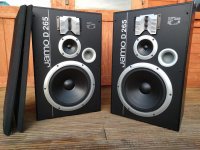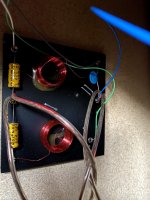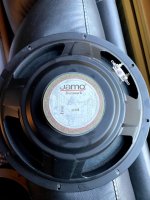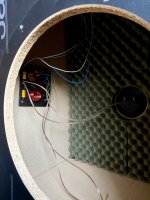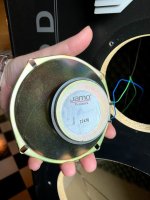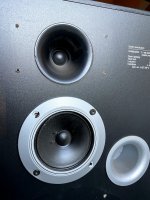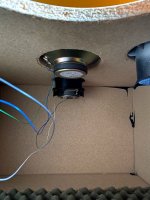Hello everyone!
I am thinking if someone could help me on my project - Upgrading a pair of Jamo D 265 C speakers on the cheap! While I know you can’t make a cheap speaker great, certainly we could make these better without spending a fortune, all while learning something along the way. Isn’t that the spirit of DIY? 😉
The speakers are Danish made, vented box with a 12” bass driver, a 5” (or so about) midrange and then a tweeter which I ain’t familiar with yet. The speaker box itself is made out of particle board with a decent thickness. But it has no bracing and very minimal damping. Also the bass / mid are quite badly fastened to the box, using plastic rings to compress driver to the box, without any sealing material in between the speaker and the box. The crossovers are pathetic, as is the cabling which has a diameter barely visible to the eye. These I would like to improve by learning how to build new crossovers, of course not using any high end components but standard ones of decent quality.
So my first mods will be: Bracing the cabinets lightly, adding some damping material to surfaces except baffle and add light stuffing. And then I would like to upgrade / make new crossovers. But with that I really need help.
Bildresultat på Google
Could anyone help a man in need? Thanks!
I am thinking if someone could help me on my project - Upgrading a pair of Jamo D 265 C speakers on the cheap! While I know you can’t make a cheap speaker great, certainly we could make these better without spending a fortune, all while learning something along the way. Isn’t that the spirit of DIY? 😉
The speakers are Danish made, vented box with a 12” bass driver, a 5” (or so about) midrange and then a tweeter which I ain’t familiar with yet. The speaker box itself is made out of particle board with a decent thickness. But it has no bracing and very minimal damping. Also the bass / mid are quite badly fastened to the box, using plastic rings to compress driver to the box, without any sealing material in between the speaker and the box. The crossovers are pathetic, as is the cabling which has a diameter barely visible to the eye. These I would like to improve by learning how to build new crossovers, of course not using any high end components but standard ones of decent quality.
So my first mods will be: Bracing the cabinets lightly, adding some damping material to surfaces except baffle and add light stuffing. And then I would like to upgrade / make new crossovers. But with that I really need help.
Bildresultat på Google
Could anyone help a man in need? Thanks!
Not sure on those speakers, but my experience with "improving" commercial equipment has been unsuccessful...
As you said bracing and damping the cabinets would be an obvious starting point.
Improving the mounting and sealing might help, you might be able to cheat and use a decent silicone sealant to seal them back up (not bathroom sealant, a slow curing type). Or you can get decent sealing tapes (not draught excluder/door sealer).
Anything more, if it starts costing money, you might as well put that into better speakers (second hand) or start building something from scratch?
As you said bracing and damping the cabinets would be an obvious starting point.
Improving the mounting and sealing might help, you might be able to cheat and use a decent silicone sealant to seal them back up (not bathroom sealant, a slow curing type). Or you can get decent sealing tapes (not draught excluder/door sealer).
Anything more, if it starts costing money, you might as well put that into better speakers (second hand) or start building something from scratch?
Thanks for your reply. I am indeed looking into another DIY project this winter for some Troels Gravesen floorstanders. This JAMO project is just a little something to tinker with during the coming autumn evenings. I got these speakers for free and I don’t really mind spending a bit to improve them, just as a way to learn basically. I have other speakers that I am using normally anyways. I am interested to see if someone has more info on the drivers in these and if there are any obvious upgrades or affordable replacement drivers that would thrive in the existing box.
All I would say is that the cost of the wood for my home built speakers, was less than the cost of one of the bass drivers.
If you are going to buy more drivers, and there are some good low cost parts, you might as well build some cabinets to put them in there (if you have the tools and time).
Would be easier to build a new cabinet for good low cost drivers, instead of trying to fit something into another design.
If you are going to buy more drivers, and there are some good low cost parts, you might as well build some cabinets to put them in there (if you have the tools and time).
Would be easier to build a new cabinet for good low cost drivers, instead of trying to fit something into another design.
I have glued floor tiles on the inside walls of flimsy cabinets to stiffen the walls. This together with bracing usually improves a resonant box a lot.
That 'Pro' look takes me back to my DJ days!
Just love the acoustic lens which conceals what is said to be a cone tweeter.
Post some photos of the crossover components. At least it will be worth replacing any old electrolytic capacitors.
Yes I will try to give you some pictures today. The crossovers are very poor looking things. I think I will try doing the bare minimum to filters and enclosures to see if it makes any difference, otherwise I'll mount the speakers in the garage 😉
A crossover redesign will probably help, though it will not be cost effective. It is a big challenge and you will learn a lot, so that could be a reason to do it.The crossovers are pathetic, as is the cabling which has a diameter barely visible to the eye. These I would like to improve by learning how to build new crossovers, of course not using any high end components but standard ones of decent quality.
Pathetic wiring is not a problem. Calculate the resistance of 30 cm of such wire and compare to the dc resistance of a crossover coil (woofer) or series resistor (mid, tweeter). 🙂
You are most right about the cabling. It is probably more a visual issue than a real issue 😊 But the speakers themselves would probably benefit greatly from a better crossover but then the issue is a lack of driver specifications...
The tweeter is a dome tweeter in a small ”horn”. The mid driver is a closed one ”Jamo item 22470” and the bass driver is ”jamo item 22325”. From the crossover the green/blue wires go to mid, grey/black to tweeter. As can be seen there isn’t much damping inside the box.
Better to attach your images Nautinto - instructions in the rules somewhere.
Very basic crossovers - 2 coils, 2 NP electrolytic capacitors and a polyswitch speaker protection component (the blue disc).
Probably not worth changing the capacitors, but they're all you should bother to change - apart from the wiring, if you want to tidy things up a bit.
Very basic crossovers - 2 coils, 2 NP electrolytic capacitors and a polyswitch speaker protection component (the blue disc).
Probably not worth changing the capacitors, but they're all you should bother to change - apart from the wiring, if you want to tidy things up a bit.
It's worth attaching some damping to the walls. One way was suggested earlier. Bracing is also a possibility.As can be seen there isn’t much damping inside the box.
I see the rear wall has foam absorbent attached - I would add some to the top, bottom and side walls on top of some damping material.
Note: Do not 'stuff' this reflex cabinet - absorbent on walls only.
Last edited:
Is measuring out of the question?a better crossover but then the issue is a lack of driver specifications...
Interesting waveguide, this just keeps getting better.
So this suggests the mid cone might be running to its upper limit. Maybe it should have a more steep low pass filter on it?
So this suggests the mid cone might be running to its upper limit. Maybe it should have a more steep low pass filter on it?
Is measuring out of the question?
I do not own measuring equipment, so I guess yes it is out of question. Surely it would be very helpful to have this information.
I would just keep on listening if can't measure.
But it would have been fun to take full vituixcad data from these. Maybe could have been even improvement.
You are doomed if you can't measure
But it would have been fun to take full vituixcad data from these. Maybe could have been even improvement.
You are doomed if you can't measure
Nautinto,
I think you have the right approach to start with:
- stiffening the box
- more absorption material inside to cut off reflections
That is a great first step. Do it and then listen for a week or two.
If still not satisfied then:
- you can play with the x-over, mainly change the BP caps to film ones, see if you'll like the sound
Further steps down the line:
- I would remove the mids dust caps and replace them with phase plugs, but I like taking risks, this action is not reversible
- I would listen to and test the speaker, impedance and freq. response, and if possible try to convert it to an Aperiodic one because I do not like reflex speakers
Actually this you can quickly try yourself by sticking some soft material like foam or cloth inside the ports and listen, and listen again, and then test.
Believe me, no matter what everyone says, listening is more important than measuring.
After a while you'll be able to rely on your listening experience more than on test instruments before making major changes.
I know some people will get very aggro with this statement but that is OK. Don't pay attention, I know I will not.
I think you have the right approach to start with:
- stiffening the box
- more absorption material inside to cut off reflections
That is a great first step. Do it and then listen for a week or two.
If still not satisfied then:
- you can play with the x-over, mainly change the BP caps to film ones, see if you'll like the sound
Further steps down the line:
- I would remove the mids dust caps and replace them with phase plugs, but I like taking risks, this action is not reversible
- I would listen to and test the speaker, impedance and freq. response, and if possible try to convert it to an Aperiodic one because I do not like reflex speakers
Actually this you can quickly try yourself by sticking some soft material like foam or cloth inside the ports and listen, and listen again, and then test.
Believe me, no matter what everyone says, listening is more important than measuring.
After a while you'll be able to rely on your listening experience more than on test instruments before making major changes.
I know some people will get very aggro with this statement but that is OK. Don't pay attention, I know I will not.
If sound comes from computer equalizer apo will help. If not, some 31-band eq can get used like 50€ or so
Good tip, thank you!
This week if I will have time I will cut and install some braces in the enclosure, and dampen the walls with bitumen and a layer of felt material. Also I will make sure the drivers are tightly seated to the box and then I will give it a good listen to how it changes.
This week if I will have time I will cut and install some braces in the enclosure, and dampen the walls with bitumen and a layer of felt material. Also I will make sure the drivers are tightly seated to the box and then I will give it a good listen to how it changes.
- Home
- Loudspeakers
- Multi-Way
- Improving JAMO D265 C speakers on the cheap
